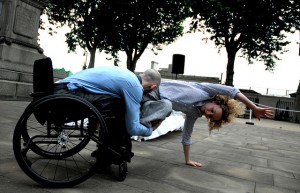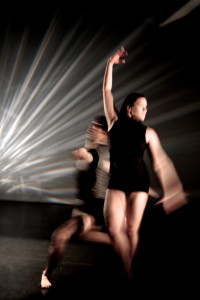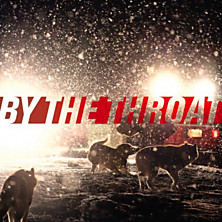"Classical music and rock'n'roll have never got on too well. It's been the problem of rock since about 1966 - probably about the time that the Velvet Underground started fiddling about in Warhol's Factory. It wants to be taken seriously as art. There's nothing worse than stupid rockers trying to make serious music. Don't believe me? I've got the complete works of Yes on my hard drive, have a listen."
"Are you saying you don't like Lou Reed?"
"Never met him. But he doesn't come across too well when Lester Bangs interviewed him. The point isn't whether the Velvets are any good - but the presence of a vinyl copy of their first album in Urban Outfitters suggests that they are more of a fashion accessory than a vital musical force these days. Yes, I know they don't make music any more, but part of the recording revolution ensured that music could exist even after the musicians had had their respective emotional or pharmaceutical crises-"
"This is the last time I ever take you to a concert. You just enjoy moaning..."
"(Expletive deleted). No, I am developing a critical discourse around the status of electronic music. With added alcohol. I'm not saying that
Ben Frost comes out of the same tradition as the progressive rock of the 1970s - frankly, you wouldn't have got me in there if I thought he had anything to do with Jethro Tull. But the event we saw tonight did enforce the idea that rock and classical ought to remain in opposition."
"Ben Frost isn't rock'n'roll, and it's another one of your deliberate misreadings to suggest otherwise. Your ambition seems to revolve around applying inappropriate aesthetic parameters..."
"And seeing what happens. I've explained this before. I do exactly what Ben Frost does - I test what happens when you place one art form in a different context. Admittedly, Ben Frost is probably more interesting in The Old Fruitmarket than I am wandering around The Merchant City full of coffee..."
"Do you want to tell me why you think Ben Frost is rock'n'roll? Here's the objections: he uses a laptop to manipulate sound, he shapes albums in a way that has little in common with traditional pop structure and the three minute track. He takes on major themes and is not limited by the industry that surrounds rock music..."
"Yes were under the impression that their albums were influenced by eastern philosophy. That's a "major theme". But that isn't the point. Frost's instrumentation echoes the rock format: guitars, a bit of drumming and the electronics, although manipulated by a computer, are just a natural move from the experimental approaches of bands like Swans. Remember the start of the gig, before he came on. There was the new Swans album playing and his kit was all over the stage. A computer - I love the way he taped the cover to hide the brand, so anti-commercial - a drum kit which is probably pretty close to the ones used by every rock'n'roller since Elvis - and a big whack of speakers. That was all an announcement: I am here to rock. And rock is the musical form that is most concerned with volume."
"I'd argue that the laptop is more associated with either techno or the soundscaping that is so often used for choreography..."
"See, this is what makes Frost fascinating. He comes from a tradition that includes Brian Eno - his ambient music militates against rock's macho posturing - someone even wrote a book about how Eno's production style was the antithesis of rock'n'roll. But Eno was in Roxy Music and he produced U2. They might not be fashionable - and part of their uncoolness comes exactly from the awkward sterility of Eno's production against the band's instinct to be a good time rock'n'roll band - but U2 are a by-word for stadium rock."
"Even Eno can't make U2 hip. But that's probably because of Bono. So is Eno, and this tradition you are inventing, rock or not rock?"
"It's both. That's the tension we saw played out tonight. On one level, there's no reason at all for Frost to perform
By The Throat live. It's a wonderful recording, made all the more fascinating by the process of creation - those wolf sounds were apparently made on a double-bass. And it is conceptually complete. It's a studio creation, and although he remixes it live, it doesn't need the presence of the performer to make it immediate and visceral."
"But by playing it live, he adds the presence - which is very rock'n'roll, I suppose. And all those instruments - signifiers of rock?"
"Yep, and rock itself is a signifier of something aggressive, energetic, powerful. In theory, adding that to
By The Throat lends it... well, a toughness. And look at how Frost performed - guitar slung over the shoulder, getting the drummer on to give it some tribal punch. It's rock'n'roll right there."
"However... after your first sip of that double espresso, you were burbling about classical music. Was that just the caffeine talking?"
"No, it's where the problems come in. Something about Apollo and Dionysus. The way that the venue was designed for a classical show - "
"There were no seats, that's rock..."
"Yeah, but most people just stood and watched. The lack of seating is more usually to give people space to dance."
"I saw that you went for a stroll."
"I was dancing. I was improvising a one man non-contact jam. Interestingly, the music was much more exciting when I was pacing about. But the way the actual music was presented, the way it was received, had more in common with a classical concert. And, given the best way to listen to the album is as a single piece, the audience weren't wrong... unlike me, they weren't misreading it."
"That's the non-rock part being played out, then? And his lack of rock'n'roll front man antics. As theatre, it's pretty boring to watch."
"Hence people have a wee lie down, or closing their eyes to listen. Or me staring at the bar for ten minutes, watching people buy drinks to this glacial soundtrack. With the red neon above, it became a lost scene from a David Lynch movie."
"So you are saying that the gig served two functions - or has a dual identity? Rock and not rock? But that's fascinating."
"If you perceive it through a series of sign-systems, yes. But rock draws on an energy that is immediate and visceral. So, as rock, it fails."
"So it's classical?"
"Well, I didn't get confused and think I was listening to Arvo Part, so no."
"It's beyond classification?"
"We could call it "electronica" and recognise that the simplistic systems I have applied don't work. Electronica craves its own format for performance, but falls back into the twin defaults of classical and rock."
"It's pretty hectic being you. What's it like going to a hardware store?"
"Like entering a room full of cyborgs. But I have a suspicion that Frost knows about this problem. There's a bonus track on
By The Throat called
Studies for Michael. It is a typical title for a classical piece. But I reckon the Michael in question is Gira, out of Swans. So, he's making a point about the music he makes."
"(Laughter). David Stubbs does compare bits of
By The Throat to Arvo Part. Major fail, Criticulous."




.jpg/220px-Taiko_or_daiko_drums_(from_Emil_Richards_Collection).jpg)












